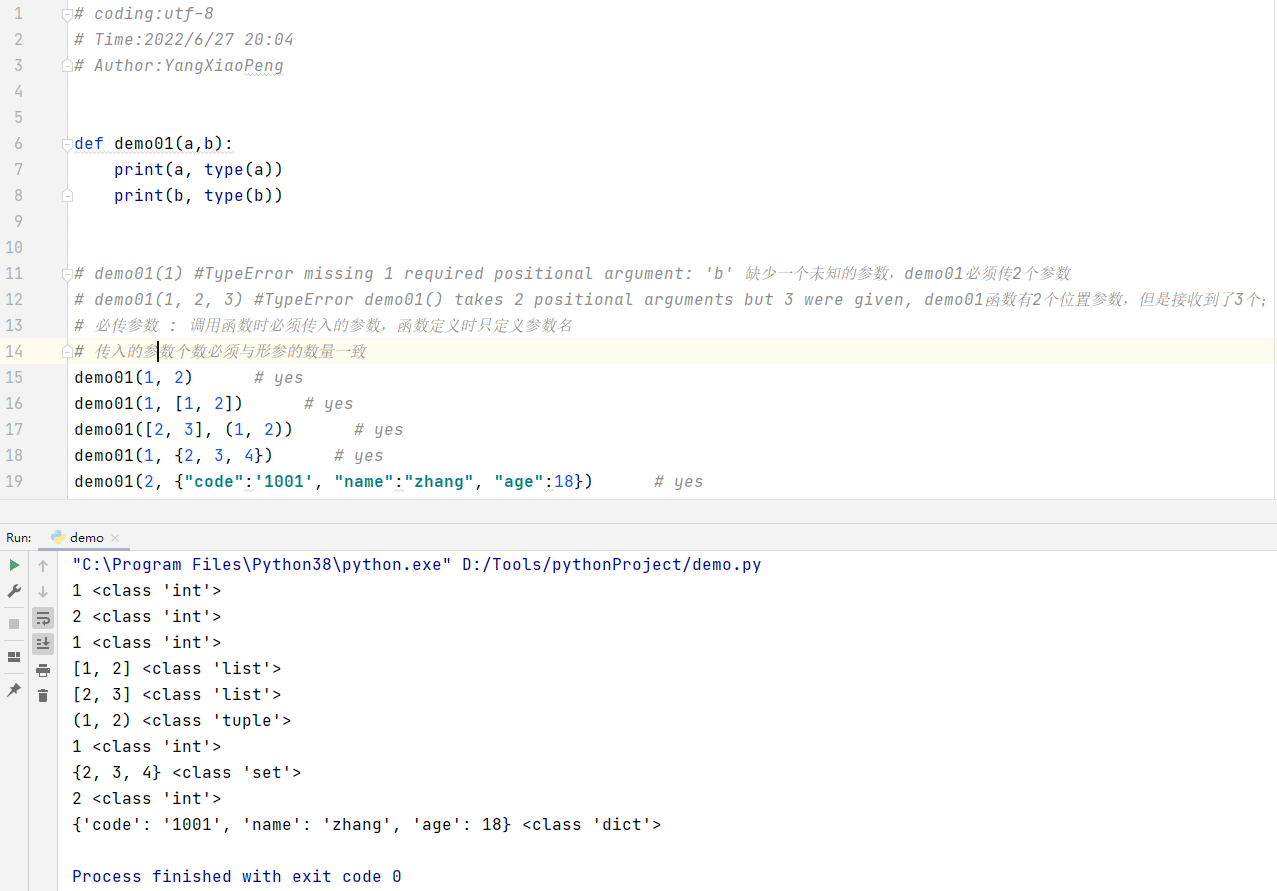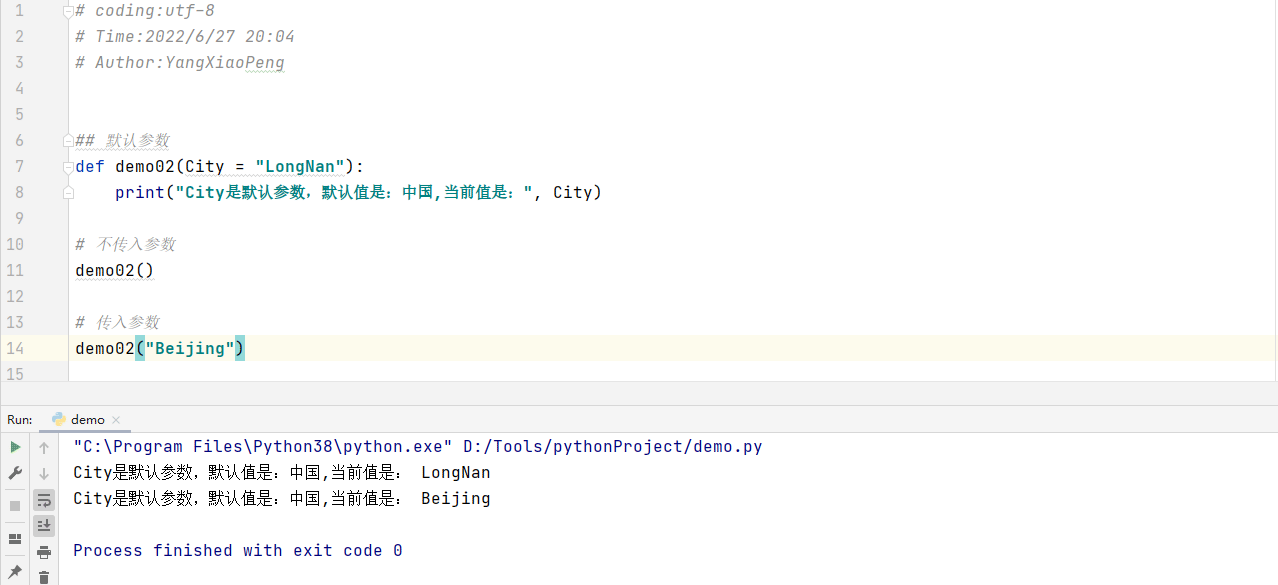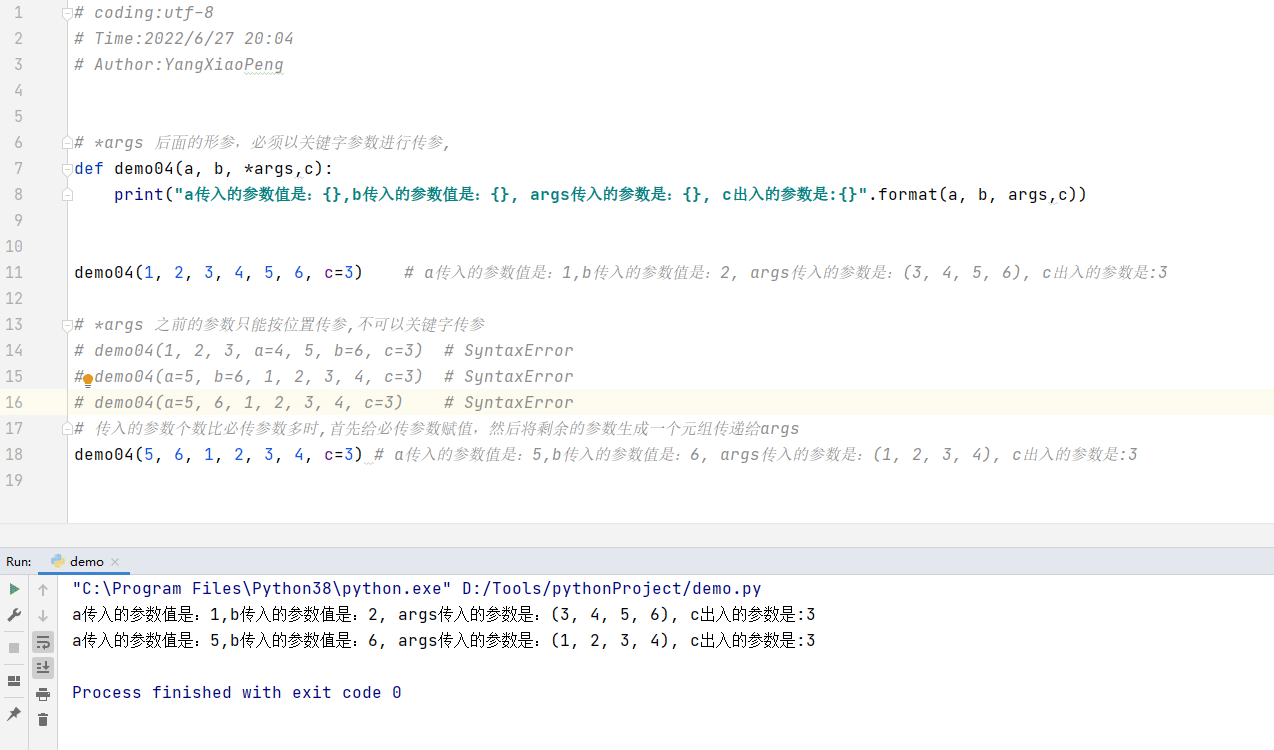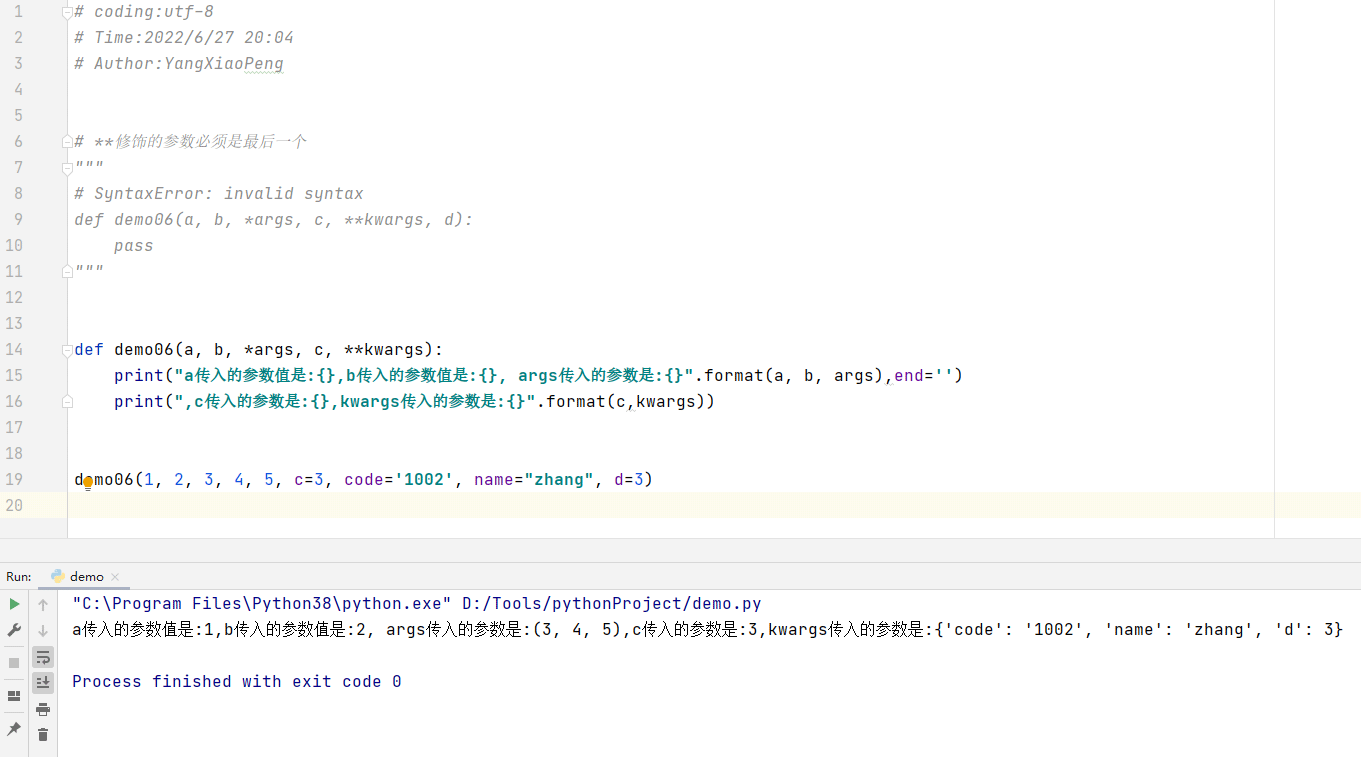жӮЁеҘҪпјҢзҷ»еҪ•еҗҺжүҚиғҪдёӢи®ўеҚ•е“ҰпјҒ
д»ҠеӨ©е°Ҹзј–з»ҷеӨ§е®¶еҲҶдә«дёҖдёӢPythonдёӯеҮҪж•°зҡ„еҸӮж•°зұ»еһӢе®һдҫӢеҲҶжһҗзҡ„зӣёе…ізҹҘиҜҶзӮ№пјҢеҶ…е®№иҜҰз»ҶпјҢйҖ»иҫ‘жё…жҷ°пјҢзӣёдҝЎеӨ§йғЁеҲҶдәәйғҪиҝҳеӨӘдәҶи§Јиҝҷж–№йқўзҡ„зҹҘиҜҶпјҢжүҖд»ҘеҲҶдә«иҝҷзҜҮж–Үз« з»ҷеӨ§е®¶еҸӮиҖғдёҖдёӢпјҢеёҢжңӣеӨ§е®¶йҳ…иҜ»е®ҢиҝҷзҜҮж–Үз« еҗҺжңүжүҖ收иҺ·пјҢдёӢйқўжҲ‘们дёҖиө·жқҘдәҶи§ЈдёҖдёӢеҗ§гҖӮ
еҝ…дј еҸӮж•°пјҡи°ғз”ЁеҮҪж•°ж—¶еҝ…йЎ»дј е…Ҙзҡ„еҸӮж•°пјҢеҮҪж•°е®ҡд№үж—¶еҸӘе®ҡд№үеҸӮж•°еҗҚ
е…ій”®еӯ—еҸӮж•°пјҡдј е…Ҙж—¶д»ҘеҮҪж•°зҡ„еҸӮж•°еҗҚеҖјеҜ№зҡ„ж–№ејҸдј е…Ҙ
й»ҳи®ӨеҸӮж•°пјҡеҮҪж•°е®ҡд№үж—¶дёәеҸӮж•°й»ҳи®Өи®ҫзҪ®дёҖдёӘеҖјпјҢи°ғз”Ёж—¶дёҚдј иҫ“еҸӮж•°еҚід»Ҙй»ҳи®ӨеҖјеӨ„зҗҶ
дёҚе®ҡй•ҝеҸӮж•°пјҡд»Ҙ*дҝ®йҘ°жҲ–иҖ…**дҝ®йҘ°зҡ„еҸӮж•°;*дҝ®йҘ°зҡ„еҸӮж•°жҳҜдёҖдёӘе…ғз»„(tuple),**дҝ®йҘ°зҡ„еҸӮж•°еҝ…йЎ»жҳҜеӯ—е…ё(dict)пјҢйҖҡеёёеҶҷдҪң*argsжҲ–иҖ…**args
дј е…Ҙзҡ„еҸӮж•°дёӘж•°еҝ…йЎ»дёҺеҪўеҸӮзҡ„ж•°йҮҸдёҖиҮҙ
# coding:utf-8
# Author:YangXiaoPeng
def demo01(a,b):
print(a, type(a))
print(b, type(b))
# demo01(1) #TypeError missing 1 required positional argument: 'b' зјәе°‘дёҖдёӘжңӘзҹҘзҡ„еҸӮж•°пјҢdemo01еҝ…йЎ»дј 2дёӘеҸӮж•°
# demo01(1, 2, 3) #TypeError demo01() takes 2 positional arguments but 3 were given, demo01еҮҪж•°жңү2дёӘдҪҚзҪ®еҸӮж•°пјҢдҪҶжҳҜжҺҘ收еҲ°дәҶ3дёӘпјӣ
# еҝ…дј еҸӮж•° : и°ғз”ЁеҮҪж•°ж—¶еҝ…йЎ»дј е…Ҙзҡ„еҸӮж•°пјҢеҮҪж•°е®ҡд№үж—¶еҸӘе®ҡд№үеҸӮж•°еҗҚ
# дј е…Ҙзҡ„еҸӮж•°дёӘж•°еҝ…йЎ»дёҺеҪўеҸӮзҡ„ж•°йҮҸдёҖиҮҙ
demo01(1, 2) # yes
demo01(1, [1, 2]) # yes
demo01([2, 3], (1, 2)) # yes
demo01(1, {2, 3, 4}) # yes
demo01(2, {"code":'1001', "name":"zhang", "age":18}) # yes
д»ҘеҸӮж•°еҗҚе’ҢеҸӮж•°еҖјзҡ„е…іиҒ”еңЁдёҖиө·зҡ„ж–№ејҸиҝӣиЎҢдј еҸӮпјҢй”®еҖјеҜ№зҡ„жЁЎејҸпјҢеҸӮж•°еҗҚдёәй”®гҖӮ
# coding:utf-8
# Author:YangXiaoPeng
def demo01(a,b):
print(a, type(a), end="__")
print(b, type(b))
# 第дёҖдёӘе…ій”®еӯ—еҮәе…Ҙзҡ„еҸӮж•°дҪҚзҪ®д№ӢеүҚзҡ„еҸӮж•°жҜ”йҖҠйҖүжӢ©е…ій”®еӯ—дј еҸӮпјӣеҰӮдёӢйқўзҡ„зӨәдҫӢдёӯпјҢ第дёҖдёӘе…ій”®еӯ—дј еҸӮзҡ„еҸҳйҮҸжҳҜaпјҢaеңЁеҮҪж•°е®ҡд№үзҡ„第дәҢдёӘдҪҚзҪ®,йӮЈд№Ҳ第дәҢдёӘдҪҚзҪ®д№ӢеүҚзҡ„еҸӮж•°йғҪеҝ…йЎ»д»Ҙе…ій”®еӯ—дј еҸӮзҡ„еҪўејҸдј еҸӮгҖӮ
# demo01(1, a=2) # demo01() got multiple values for argument 'a'
demo01(a=1, b=2) # yes
demo01(1, b=2) # yes
demo01(b=1, a=2) # yes
demo01(b=1, a=[1, 2]) # yes
demo01(b=[2, 3], a=(1, 2)) # yes
demo01(b=1, a={2, 3, 4}) # yes
demo01(b=2, a={"code":'1001', "name":"zhang", "age":18}) # yes
и°ғз”ЁеҮҪж•°ж—¶дёҚдј е…ҘеҸӮж•°anй»ҳи®ӨеҖјеӨ„зҗҶпјҢдј е…Ҙж—¶жҢүдј е…Ҙзҡ„еҸӮж•°еҖјеӨ„зҗҶ
# coding:utf-8
# Author:YangXiaoPeng
## й»ҳи®ӨеҸӮж•°
def demo02(City = "LongNan"):
print("CityжҳҜй»ҳи®ӨеҸӮж•°пјҢй»ҳи®ӨеҖјжҳҜпјҡдёӯеӣҪ,еҪ“еүҚеҖјжҳҜпјҡ", City)
# дёҚдј е…ҘеҸӮж•°
demo02()
# дј е…ҘеҸӮж•°
demo02("Beijing")
дј е…Ҙзҡ„еҸӮж•°дјҡз”ҹжҲҗдёҖдёӘе…ғз»„зұ»еһӢзҡ„еҸҳйҮҸдҫӣеҮҪж•°еҶ…йғЁдҪҝз”Ё
# coding:utf-8
# Author:YangXiaoPeng
## дёҚе®ҡй•ҝеҸӮж•°
def demo03(*args):
print(args,type(args))
# дј е…Ҙзҡ„еҸӮж•°дјҡз”ҹжҲҗдёҖдёӘе…ғз»„зұ»еһӢзҡ„еҸҳйҮҸдҫӣеҮҪж•°еҶ…йғЁдҪҝз”Ё
demo03(1)
demo03("code")
demo03(1,"code")
дј е…Ҙзҡ„еҸӮж•°дёҚиғҪе°‘дәҺеҝ…дј еҸӮж•°зҡ„дёӘж•°
*args еҗҺйқўзҡ„еҪўеҸӮпјҢеҝ…йЎ»д»Ҙе…ій”®еӯ—еҸӮж•°иҝӣиЎҢдј еҸӮ
# coding:utf-8
# Author:YangXiaoPeng
# *args еҗҺйқўзҡ„еҪўеҸӮпјҢеҝ…йЎ»д»Ҙе…ій”®еӯ—еҸӮж•°иҝӣиЎҢдј еҸӮ,
def demo04(a, b, *args,c):
print("aдј е…Ҙзҡ„еҸӮж•°еҖјжҳҜпјҡ{},bдј е…Ҙзҡ„еҸӮж•°еҖјжҳҜпјҡ{}, argsдј е…Ҙзҡ„еҸӮж•°жҳҜпјҡ{}, cеҮәе…Ҙзҡ„еҸӮж•°жҳҜ:{}".format(a, b, args,c))
# дј е…Ҙзҡ„еҸӮж•°дёҚиғҪе°‘дәҺеҝ…дј еҸӮж•°зҡ„дёӘж•°,a,b,cдёүдёӘдёәеҝ…дј еҸӮж•°
# demo04(1, 2) # TypeError
# demo04(1, 2, 3) # TypeError
demo04(1, 2, c=3)
*args д№ӢеүҚзҡ„еҸӮж•°еҸӘиғҪжҢүдҪҚзҪ®дј еҸӮ,дёҚеҸҜд»Ҙе…ій”®еӯ—дј еҸӮ
дј е…Ҙзҡ„еҸӮж•°дёӘж•°жҜ”еҝ…дј еҸӮж•°еӨҡж—¶,йҰ–е…Ҳз»ҷеҝ…дј еҸӮж•°жҢүдҪҚзҪ®иөӢеҖјпјҢ然еҗҺе°Ҷеү©дҪҷзҡ„еҸӮж•°з”ҹжҲҗдёҖдёӘе…ғз»„дј йҖ’з»ҷargs

**дҝ®йҘ°зҡ„еҸӮж•°еҝ…йЎ»д»Ҙе…ій”®еӯ—зҡ„еҸӮж•°ж–№ејҸдј еҸӮ,Pythonи§ЈйҮҠеҷЁдјҡе°Ҷдј е…Ҙзҡ„е…ій”®еӯ—е’Ңе…ій”®еӯ—зҡ„еҖјз”ҹжҲҗдёҖдёӘеӯ—е…ёдҫӣеҮҪж•°еҶ…йғЁдҪҝз”Ё
# coding:utf-8
# Author:YangXiaoPeng
def demo05(**kwargs):
print("kwargsдј е…Ҙзҡ„еҸӮж•°жҳҜпјҡ{}".format(kwargs),type(kwargs))
kwargs = {"code":'1002', "name":"zhang"}
# demo05(kwargs) # TypeError
# **дҝ®йҘ°зҡ„еҸӮж•°еҝ…йЎ»д»Ҙе…ій”®еӯ—зҡ„еҸӮж•°ж–№ејҸдј еҸӮ,Pythonи§ЈйҮҠеҷЁдјҡе°Ҷдј е…Ҙзҡ„е…ій”®еӯ—е’Ңе…ій”®еӯ—зҡ„еҖјз”ҹжҲҗдёҖдёӘеӯ—е…ёдҫӣеҮҪж•°еҶ…йғЁдҪҝз”Ё
demo05(**kwargs) # kwargsдј е…Ҙзҡ„еҸӮж•°жҳҜпјҡ{'code': '1002', 'name': 'zhang'} <class 'dict'>
demo05(code='1002',name="zhang") # kwargsдј е…Ҙзҡ„еҸӮж•°жҳҜпјҡ{'code': '1002', 'name': 'zhang'} <class 'dict'>
**дҝ®йҘ°зҡ„еҸӮж•°еҝ…йЎ»жҳҜжңҖеҗҺдёҖдёӘ
# coding:utf-8
# Author:YangXiaoPeng
# **дҝ®йҘ°зҡ„еҸӮж•°еҝ…йЎ»жҳҜжңҖеҗҺдёҖдёӘ
"""
# SyntaxError: invalid syntax
def demo06(a, b, *args, c, **kwargs, d):
pass
"""
def demo06(a, b, *args, c, **kwargs):
print("aдј е…Ҙзҡ„еҸӮж•°еҖјжҳҜ:{},bдј е…Ҙзҡ„еҸӮж•°еҖјжҳҜ:{}, argsдј е…Ҙзҡ„еҸӮж•°жҳҜ:{}".format(a, b, args),end='')
print(",cдј е…Ҙзҡ„еҸӮж•°жҳҜ:{},kwargsдј е…Ҙзҡ„еҸӮж•°жҳҜ:{}".format(c,kwargs))
demo06(1, 2, 3, 4, 5, c=3, code='1002', name="zhang", d=3)
д»ҘдёҠе°ұжҳҜвҖңPythonдёӯеҮҪж•°зҡ„еҸӮж•°зұ»еһӢе®һдҫӢеҲҶжһҗвҖқиҝҷзҜҮж–Үз« зҡ„жүҖжңүеҶ…е®№пјҢж„ҹи°ўеҗ„дҪҚзҡ„йҳ…иҜ»пјҒзӣёдҝЎеӨ§е®¶йҳ…иҜ»е®ҢиҝҷзҜҮж–Үз« йғҪжңүеҫҲеӨ§зҡ„收иҺ·пјҢе°Ҹзј–жҜҸеӨ©йғҪдјҡдёәеӨ§е®¶жӣҙж–°дёҚеҗҢзҡ„зҹҘиҜҶпјҢеҰӮжһңиҝҳжғіеӯҰд№ жӣҙеӨҡзҡ„зҹҘиҜҶпјҢиҜ·е…іжіЁдәҝйҖҹдә‘иЎҢдёҡиө„и®Ҝйў‘йҒ“гҖӮ
е…ҚиҙЈеЈ°жҳҺпјҡжң¬з«ҷеҸ‘еёғзҡ„еҶ…е®№пјҲеӣҫзүҮгҖҒи§Ҷйў‘е’Ңж–Үеӯ—пјүд»ҘеҺҹеҲӣгҖҒиҪ¬иҪҪе’ҢеҲҶдә«дёәдё»пјҢж–Үз« и§ӮзӮ№дёҚд»ЈиЎЁжң¬зҪ‘з«ҷз«ӢеңәпјҢеҰӮжһңж¶үеҸҠдҫөжқғиҜ·иҒ”зі»з«ҷй•ҝйӮ®з®ұпјҡis@yisu.comиҝӣиЎҢдёҫжҠҘпјҢ并жҸҗдҫӣзӣёе…іиҜҒжҚ®пјҢдёҖз»ҸжҹҘе®һпјҢе°Ҷз«ӢеҲ»еҲ йҷӨж¶үе«ҢдҫөжқғеҶ…е®№гҖӮ
жӮЁеҘҪпјҢзҷ»еҪ•еҗҺжүҚиғҪдёӢи®ўеҚ•е“ҰпјҒ